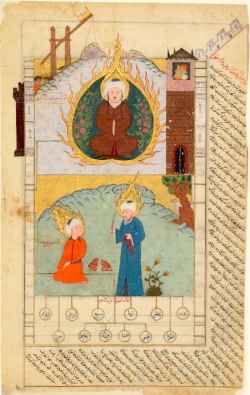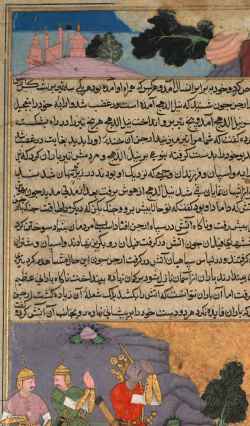Topic: 2. Sacrifice and religion: Comparisons, Antiquarians, Anthropology (16th-18th Century)
Religious sacrifices across various cultures and contexts sparked widespread interest in Early Modern Europe. As Christianity expanded into regions inhabited by "infidels" and "pagans", Europeans encountered a diverse array of sacrificial customs, ranging from the Sati rituals in India to the Aztec sacrifices in the Americas. This cross-cultural exposure captivated a wide audience, including theologians, philosophers, political thinkers, antiquarians, orientalists, missionaries, poets, artists, and even the general public. These encounters broadened the European understanding of sacrifice and led to a critical reassessment of classical and biblical sacrificial rites. This section includes:
- Sources: A selection of early modern printed materials, which include descriptions of the Americas, Asia, and Africa, alongside antiquarian and philological studies on religious sacrifice in classical antiquity and beyond. It also presents early modern works of ethnological observations and the first attempts to compare different sacrificial practices in various traditions and contexts, laying the groundwork for disciplines like the history of religions and anthropology.
- Iconographic Representations: A rich collection of images from the 16th to 18th centuries, illustrating a range of sacrificial rituals and practices as seen in different cultural and geographical contexts.
- Related Bibliography: An extensive bibliography spanning scholarly works from the 19th to 21st centuries, providing contemporary analyses and interpretations of these early studies and observations.
John Selden et les origines de l’orientalisme
in: John Selden: juriste européen, pp. 1-11
Paris: Annuaire de l’Institut Michel Villey, 2012.
Sacrifice and Martyrdom in the Roman Empire
in: Archivio Di Filosofia [Special issue: Il sacrificio], v. 76 (2008), issue 1: pp.145-154.
2. Sacrifice and religion: Comparisons, Antiquarians, Anthropology (16th-18th Century) 3. Sacrifice and politics (16th-18th Century)
Sacrorum, Sacrificiorumq[ue] Gentilium Brevis Et Accurata Descriptio: universae Superstitionis Ethnicae ritus cerimoniasq[ue] complectens: Ad Sacros Et Profanos Scriptores probe intelligendos explicandosq[ue] peraccommodata: Ex Antiquissimis probatissimisq[ue] Auctoribus depromta et nunc primum
Zürich: Johannis Wolphius, 1598.
Sacrorum, sacrificiorumque gentilium brevis et accurata descriptio
Zürich: Johannis Wulpius, 1598.
Rungs about Aqiqa (new-born immolation)
in: Contemporary Jurisprudence Research Journal / Majallat al-Buḥūth al-Fiqhīyah al-Muʿāṣirah, v. 80 (2008), issue : pp..
Mass human sacrifice and symbolism of the Feathered Serpent Pyramid in Teotihuacan, Mexico
Tempe: Arizona State University Anthropological Research Papers, 1995.
The sacrifice of Isaac. The Prophet Ibrahim (Abraham) surviving the furnace (above), and preparing to sacrifice his son Ism'il (below), from The Cream of Histories (Zubdat al-tawarikh) by Sayyid Luqman-i 'Ashuri (1585)
from: Sayyid Luqman-i Ashur, Zubdat al-tawarikh, Istanbul, Turkey
Sayyid Luqman-i Ashur, Zubdat al-tawarikh, detached folio, Chester Beatty Library, Dublin
"The First Adventure of the White Horse". The king performed the horse sacrifice in order to determine the extent of his rule. For one year a horse wanders and every land through which the horse passes becomes part of the king’s territory. Arjuna following the horse encountered the son-in-law of the god of fire, Agni, who creates a river of fire to block the warriors. Arjuna pleads with Agni, the god of fire that the horse be allowed to pass, saying that the horse sacrifice is in accordance with sacred Vedic injunctions, and that at the end of the year, the horse will be sacrificed to him, the god of fire himself. (1610-1617)
from: Page from the Khan Khanan's Razm Nama (Book of Wars)
The Cleveland Museum of Art
De l'universalité d'une forme africaine de sacrifice
Paris: Centre national de la recherche scientifique, 1988.
The Nature of Moche Human Sacrifice: A BioArchaeological Perspective
in: urrent Anthropology, v. 46 (2005), issue 4: pp.521–549.
Il taglio della poesia. Note sulle origini sacrificali della poetica greca
in: Sacrificio e società nel mondo antico, pp. 231-252
Roma - Bari: Laterza , 1988.
Mapping Hinduism: Hinduism and the study of Indian religions, 1600-1776
Halle: Verlag der Franckeschen Stiftungen zu Halle, 2003.
Cities of Violence: Sacrifice, Power and Urbanisation in the Andes
in: Journal of Social Archaeology , v. 3 (2003), issue 2: pp.256–296.
An essay upon the nature, design and origin of sacrifices
London: [John] Knapton ; [Paul] Knapton, 1748.
Ritual Slaughter Issue In Poland: Between Religious Freedom, Legal Order And Economic-Political Interests
in: Religion and Society in Central and Eastern Europe, v. 7 (2014), issue 1: pp.53-69.


